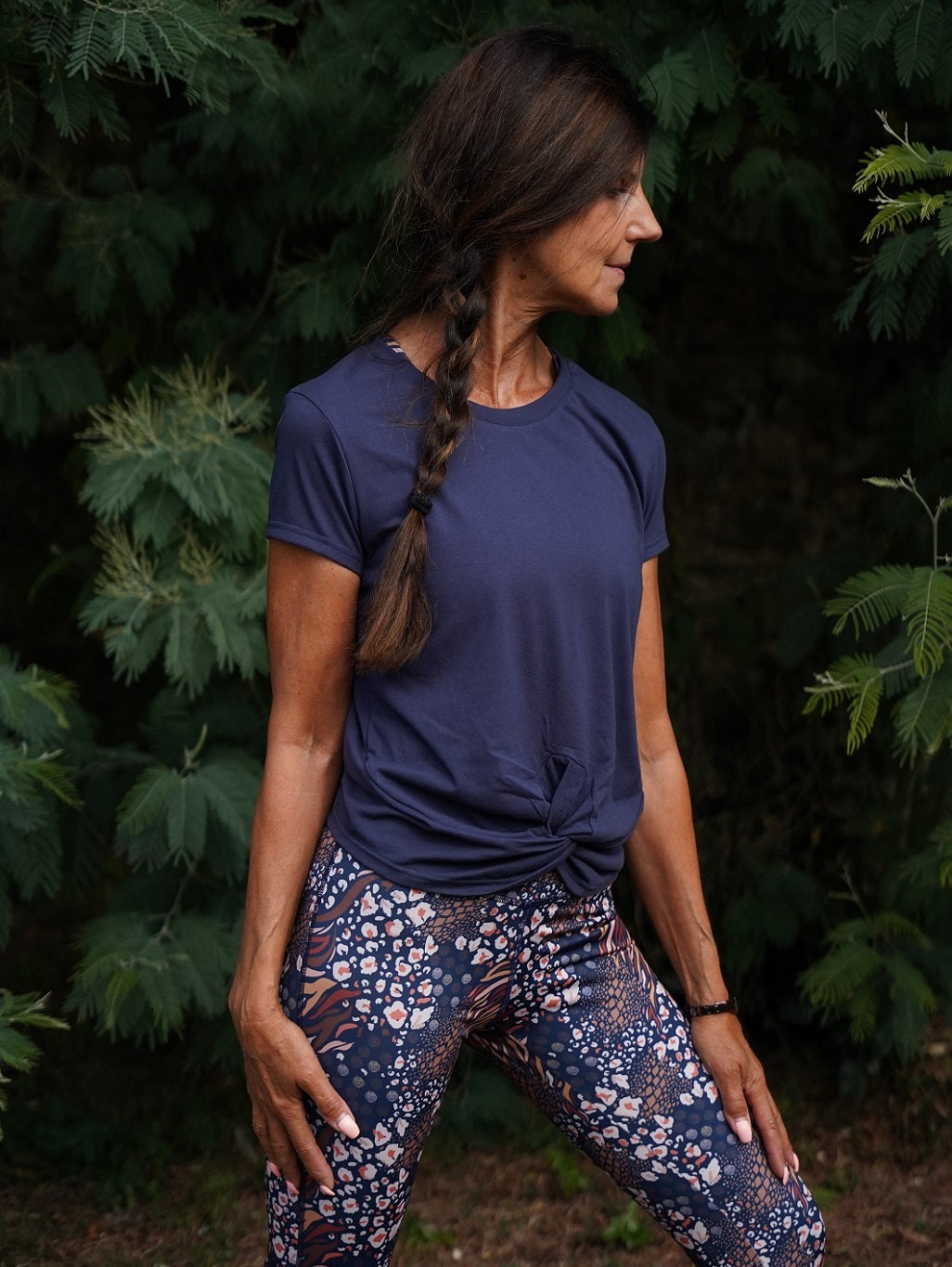Codified by the sage Patañjali in the Yoga Sūtra , yoga is an art of living governed by yamas (rules of conduct) and niyamas (personal disciplines). Among them: aparigraha , non-attachment in Sanskrit . This teaching , which is at the heart of the Bhagavad Gita (fundamental text of Hinduism ), teaches us to focus our attention on action rather than on the result or to detach ourselves from the desire for accumulation . But concretely, how to practice the fifth yama on a daily basis? And on her yoga mat ? Here are 3 ideas for traveling (lighter) in life…

1 – Adopt a more minimalist lifestyle
In this frantic race for happiness, we wrongly believe that the more we have, the closer we get. We then pile up clothes in the closets, sometimes new, books never opened on the shelves or we add to a collection of pairs of single-use shoes. However, the more we accumulate material goods, the more we weigh ourselves down with baggage, not only physical, but also energetic.
Aparigraha does not mean totally renouncing all attachments to material life, in the manner of the sadhus in India who devote their existence to the spiritual quest. Transposed into the society in which we live, this yogic virtue consists of giving less importance to our possessions, and rethinking and reducing our consumption.
To apply this fifth yama , start by asking yourself the following questions. They will allow you to sort through your belongings:
- Does this item fill me with joy when I wear it or use it?
- Do I only keep it in case I need it one day?
- Do I really have regular use for it or would someone around me have better use of it than me?
Once the spring cleaning is done, think twice when you're about to make a new purchase. Apply the BISOU method to consume better:
- B (need): what real need does this respond to (esteem, comfort, change, etc.)?
- I (immediate): is this a compulsive purchase or does my desire to acquire persist, even after two weeks?
- S (similar): Do I have something similar at home that might work?
- O (origin): did this product cross the planet to get here? What resources were used to make it? For example, at Géopélie, we exclusively design clothing made in France from recycled materials!
- U (usefulness): if I buy this object, will it have a positive impact on my daily life? Will I use it regularly or can I borrow it or rent it?
Now that you've asked yourself the right questions, maybe it's time to free up some space within yourself...

2 - Eat in a more reasoned and moderate way
According to 2019 figures from the Food and Agriculture Organization of the United Nations, almost 17% of food produced globally is thrown away. Stop wasting by assessing your real food needs from the shopping list: this is also practicing non-greed.
So, to calm your gluttony and eat in sufficient quantity, you can take inspiration from the Japanese saying “ hara hachi bu ”. This principle, widely applied in the blue zone of Okinawa, where the longevity of the inhabitants breaks records, results in stopping eating at 80% satiety. But, for us Westerners, how can we recognize this unfamiliar moment?
In Ayurvedic medicine, the ideal proportion of food is easy to measure. This is the equivalent of the size of your two fists. Once at the table, add the following rituals to this method:
- slow down your fork stroke;
- focus your attention on flavors and colors;
- limit your interactions with others;
- stay away from any distractions (TV, cell phone, etc.).
These habits will not only facilitate digestion and assimilation of food, but they will also allow you to feel and recognize the signals sent by your full stomach. Eating mindfully is a call for moderation.
In many reference works devoted to the philosophy of yoga, excessive consumption is even seen as an obstacle on the path to practice. And that's not the only thing...

3 - Learn to breathe to apply aparigraha on the mat
The fifth yama is a powerful principle to help you live in the present moment without interest in the past and the future. It particularly takes on its meaning in your yoga practice.
Very often, before even taking action, we look for the fruits of the practice: a peaceful mind, more fluid movements, a more relaxed or flexible body, etc. Eventually, we lose sight of the real reason we rolled out the carpet.
The session then takes on the appearance of a performance demonstration. The ultimate goal is no longer to (re)connect with yourself and be present, but to surpass yourself in a posture or compare yourself to others. However, aparigraha also teaches abandoning any idea of perfection by being more lenient with oneself. Practice for yourself and within yourself with contentment.
Demonstrating the absence of covetousness on the mat therefore amounts to welcoming a practice different from that of the day before by leaving the acquired knowledge behind. This movement of acquisition and loss is comparable to breathing:
- The inspiration to receive everything, take everything.
- The exhalation to give everything, give everything back.
Aparigraha can be practiced through prāṇayāma (breathing exercise) kapalabhati (breathing of fire). Considered a kriyā (internal cleansing technique), this yogic breathing leads to serenity by detoxifying and energizing the body. What if you started your session this way?
https://www.youtube.com/watch?v=ZNqk8FHfyS4
To not miss the release of our next articles, subscribe to our newsletter at the bottom of the page 👇 and join the beautiful Géopélie community!
Article written by Mélissa Becquet
Sources :
ADELE, Deborah. The Yamas and Niyamas, Exploring Yoga's Ethical Practice . Duluth: On-Word Bound Books, 2014, 161 pages.
FERREUX MAEGHT, Angèle and VALINDUCQ, Vincent. Blue Zones, The secrets of extreme longevity . Paris: Éditions First, 2019, 280 pages.
Food and Agriculture Organization of the United Nations. In 2019, 17 percent of the total food available to consumers was wasted. Technical platform on the assessment and reduction of food losses and waste [online]. Available at: https://www.fao.org/platform-food-loss-waste/news/details/fr/c/1417198/ (04/04/22) .
Learn Shining Skull Breathing Technique- Kapalabhati Pranayama | Learn Yoga [online video]. Sikana FR. 08/29/17. Available at: https://www.youtube.com/watch?v=ZNqk8FHfyS4 (03/30/22).





Merci beaucoup pour votre commentaire ! Ravie que cet article de notre blog vous plaise :-) Moins d’affaires = moins de soucis haha. Notre article sur le minimalisme devrait vous plaire également : https://geopelie.com/blogs/journal/7-astuces-pour-une-vie-plus-minimaliste
Un bel article, construit agréablement, invité au “enlever le trop”, pour personnes engagées sur la voie du Yoga.
D’autres voies expérimentales de l’Être, prennent la même direction.
Leave a comment